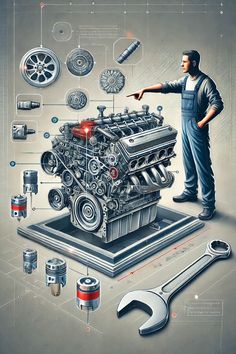The Everyday Essentials: A Guide to the Auto Parts That Keep Us Moving

For the vast majority of people, a vehicle—whether a car, truck, or motorcycle—is not a luxury but a fundamental tool of daily life. It’s the means to get to work, shuttle children to school, and run essential errands. The intricate world of auto parts can seem overwhelming, dominated by images of high-performance engines and complex racing components. However, the reality for most drivers and riders is far more practical. The most commonly used car parts and motorcycle parts are those that address wear and tear, maintain safety, and ensure reliable, day-to-day operation. This article shifts the focus from the racetrack to the driveway, exploring the auto parts that people actually use most often.
The Foundation of Motion: Maintenance and Wear Parts
The most frequently replaced auto parts are those that have a finite lifespan. They are the consumables of the automotive world, designed to be worn down and replaced to protect more expensive components. For both car parts and motorcycle parts, this category is the backbone of the repair industry and the most common point of interaction between owners and mechanics.
1. Oil and Filters: This is, without question, the most universal routine maintenance. Engine oil is the lifeblood of any vehicle, lubricating moving parts, reducing friction, and carrying away heat. Over time, oil breaks down and becomes contaminated. The oil filter, a critical companion part, traps harmful particles. Changing the oil and filter at manufacturer-recommended intervals is the single most important act to ensure engine longevity. For most people, this is a non-negotiable service they encounter regularly, making oil and oil filters the most used auto parts in the world.
2. Tires: As the only point of contact between the vehicle and the road, tires are paramount for safety, handling, and fuel efficiency. They are subjected to constant friction, temperature changes, and road hazards. Wear is inevitable. The need for new tires is a common occurrence for every vehicle owner. Whether it’s replacing a set of all-season tires on a family sedan after years of use or swapping out the specific, often more expensive, tires on a motorcycle, this is a ubiquitous need. The choice of tire—all-season, winter, touring, or sport—is one of the most significant decisions a regular consumer makes regarding car parts or motorcycle parts.
3. Brake Pads and Rotors: The braking system is the primary safety feature of any vehicle. Every time you slow down or stop, the brake pads are pressed against the rotors (or discs), creating friction that converts kinetic energy into heat. This process gradually wears down the pads, and eventually, the rotors themselves. Squealing noises, a longer stopping distance, or a shuddering brake pedal are common signs that prompt owners to seek these essential replacement auto parts. For motorcycles, where braking precision is even more critical, maintaining pads and rotors is a vital aspect of ownership.
4. Batteries: The vehicle battery is the silent hero, providing the massive burst of electricity needed to start the engine and powering all electronic accessories when the alternator isn’t running. Batteries have a typical lifespan of 3-5 years. A dead battery, often revealed on a cold morning, is one of the most frequent causes of roadside assistance calls. Replacing a car or motorcycle battery is a very common task, making it a top-tier item in the world of commonly used auto parts.
5. Wiper Blades and Fluid: Visibility is safety. For car owners, worn-out wiper blades that streak and chatter are a constant nuisance and a hazard during rain or snow. Replacing them annually is a simple, cheap, and incredibly common maintenance task. Windshield washer fluid is also a consistently used consumable, essential for clearing road grime. While motorcycles don’t have wipers, the need for clear visors and helmets makes anti-fog sprays and cleaning solutions their analogous “visibility” consumables.
The Unseen Protectors: Filters and Fluids
Beyond oil, several other filters and fluids play a crucial role in a vehicle’s health and are regularly replaced by the average owner or their mechanic.
1. Air Filters: The engine air filter protects the heart of the vehicle by preventing dust, dirt, and debris from entering the combustion chambers. A clogged filter restricts airflow, reducing performance and fuel economy. Replacing a dirty, paper-style air filter with a clean one is a standard part of most service intervals and is one of the easiest car parts for a DIY enthusiast to handle.
2. Cabin Air Filters: A relatively modern but now standard feature, the cabin air filter cleans the air entering the vehicle’s interior through the heating and air conditioning system. It traps pollen, dust, and other pollutants. For people with allergies or those who drive in dusty environments, replacing this filter is a common way to improve in-cabin air quality.
3. Spark Plugs: These small but mighty components provide the spark that ignites the air-fuel mixture in the engine’s cylinders. Over thousands of miles, spark plugs wear out, leading to rough idling, misfires, and poor fuel economy. Replacing a set of spark plugs is a standard maintenance procedure on most vehicles’ service schedules, placing them firmly in the category of frequently used auto parts.
The Reactive Replacements: When Things Go Wrong
While maintenance parts are replaced proactively, other components are commonly used as reactive replacements when they fail.
1. Headlights and Taillights: Light bulbs burn out. It’s a simple fact. Whether it’s a traditional halogen bulb, a brighter LED, or a modern HID assembly, replacing failed lighting is an extremely common occurrence. Properly functioning lights are legally required and essential for safe night driving, making bulbs some of the most purchased car parts.
2. Suspension Components: Shocks and Struts: While not replaced as often as brakes or oil, worn-out shock absorbers or struts are a very common repair as a vehicle ages. They control the ride and handling by dampening the bounce of the springs. When they fail, the vehicle may bounce excessively, tire wear increases, and braking becomes less stable. For many owners of older vehicles, replacing shocks or struts is a standard procedure to restore a comfortable and safe ride.
3. 12-Volt Accessory Outlets (Cigarette Lighters): While their original purpose has faded, the 12-volt socket is now the primary power source for in-car electronics like phone chargers, dash cams, and GPS units. These sockets are prone to failure from wear and tear or a blown fuse. Replacing them or the associated fuses is a minor but remarkably common fix in the realm of everyday car parts.
The Real World of Auto Parts
The narrative of high-horsepower and track-day glory, while exciting, does not reflect the daily reality for the millions of vehicle owners worldwide. The true workhorses of the auto parts industry are the humble, essential components that keep our daily transportation running safely, reliably, and efficiently. From the routine oil change to the necessary replacement of tires and brakes, it is these fundamental car parts and motorcycle parts that form the core of the automotive experience for the vast majority. Understanding these common parts empowers owners to make informed maintenance decisions, ultimately saving money, enhancing safety, and ensuring their vehicle remains a dependable partner on the road of life.
